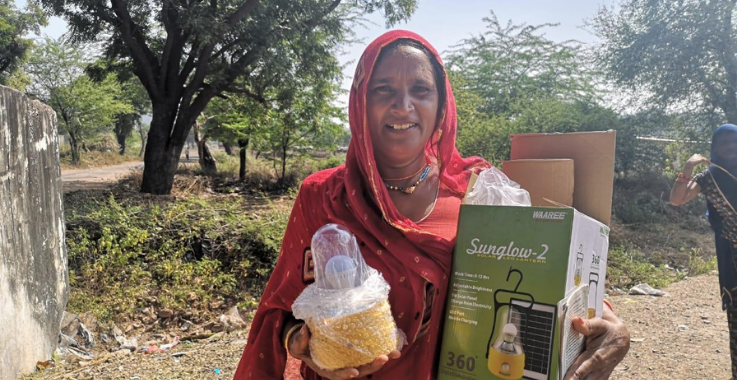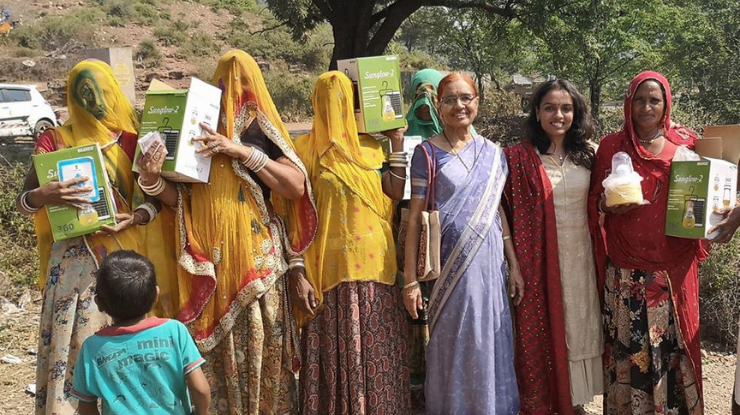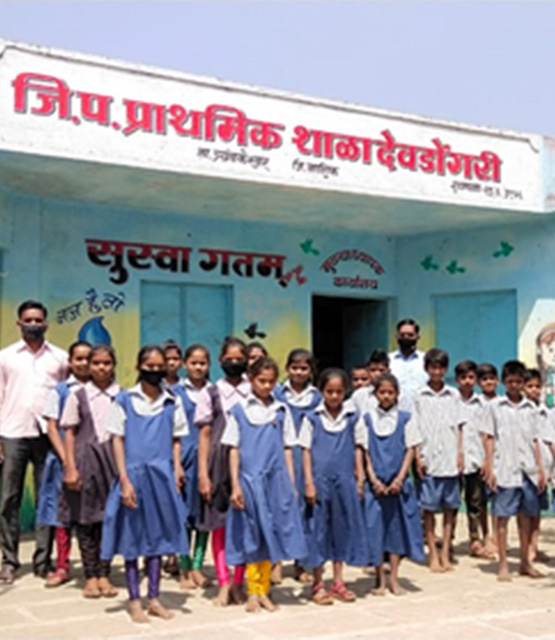
Electricity – just a flick of a switch away for most of us, but still a distant reality for many. Without electricity, the women in the villages have no option but to complete their chores before dusk, and children find it challenging to study in the dark. Women use kerosene lamps, which damage their lungs and harm the environment.
We aim to light up these non-electrified villages in rural and tribal India with solar power India. In order to achieve our goal, we are providing families with solar lanterns that can work seamlessly for 18 hours. We also spread awareness and educate people on the benefits and uses of solar energy. As of today, we have distributed solar lanterns to 65 families in the village of Kolipura, Rajasthan.


Story of Jamunbai
Jamunbai is one of the women in the 65 families residing at Kolipura, a village in the Kota district of Rajasthan. Kolipura comes under the Mukundara Hills National Park area. She said that she has always lived in this village, and her family has depended on the sale of milk from her two cows. Since the time of her marriage, she has lived in the mud house, and there are no pucca houses in the village. The village remains unelectrified as it falls in the National Park area. Lack of electricity poses several problems like no household chores can be done after sunset. Children cannot study after the evening, and some of the kerosene lamps they use have serious health issues. Despite having almost no material possessions, Jamunbabai gives us a beaming smile as we gift her a solar lantern this Diwali. She is super excited to open it and learn how to operate it. The mere fact that there will be light in her house after the sunset makes her feel elated. As we explained to Jamunabai and all the other ladies how to operate the solar lanterns, it was a feeling familiar to all of us that this was the real Diwali we had celebrated in a long time; by lightning up lives of the dark homes of a remote unelectrified village in Rajasthan.

States with a larger proportion of schools with access to electricity have higher literacy rates in India.*
Your contribution will bring power to schools in remotest non-electrified villages. Help us to ensure energy equity across India.
*Economic Survey of India
Harnessing solar power in the non-electrified schools in Tribal India
As per Unified District Information System for Education (UDISE) report, 2017-18, 63.14 per cent schools have power supply. That means over 36 per cent of schools across the country do not have electricity. This results in student absenteeism, increased dropouts, poor learning environment and ineffective teaching, ultimately translating to poor educational outcomes.
‘Samarpann’ has conceptualised the ‘Aditya School’ project to undertake solar electrification of the non-electrified government schools in remote villages of India.

A list of the non-electrified schools was obtained from the District Administration, Nashik. Three Zila Parishad schools were identified in Triambkeshwar located in remote tribal villages of Nirgude, Deodongari and Bafanvihir, respectively. The potential applications of electricity included providing lighting, operating water purification systems, ICT and projector systems for smart classes, etc., depending on the needs. Each of the three primary schools have been fitted with a 1kW rooftop solar panel system designed to take care of energy needs of lighting of all classrooms for the entire duration the children remain in schools.

Potential benefits:
- With the installation of a 1kW rooftop solar panel system, each school will generate 1500 kWh of electricity annually and save INR 12000 annually from the school electricity bill if the school goes for a grid connection.
- Consequently, this would also result in the reduction of Carbon Emission by 31 tonnes and equivalent to planting 49 teak trees over the lifetime (Data from IISc and solarrooftop.gov.in)

- Energy is directly linked with positive gains in educational performance and quality of education, and reductions in absenteeism and dropouts.
- Lighting provides extended teaching and working hours and improve the quality of teaching.
- Electrification is also linked to more gender-equal access to education.
- Electrification of schools has positive impacts on water, sanitation, healthcare etc.
- Schools can develop a financial plan to reinvest some of their savings from the solar installation into energy-efficient devices such as LED lighting systems and further light up their adjacent areas.
- The project ensures a low carbon and clean source of energy with minimum maintenance with only an initial capital investment.
- The project also created awareness amongst the students about renewable energy and they grow up to become responsible citizens.

Lightening up the lives of students in Devdongari
Deodongari is a remote tribal village situated 75 km away from district headquarters NashikIt has a total population of 1,509 people and there are about 292 houses. According to Bhaskar, Bhaskar Pundalik Tungar, Principal, Zilla Parishad School, Devdongari, lack of electricity connection in the school created problems for students in hot summers when the temperature would soar high. This resulted in children falling sick or not attending classes. Though the school had a computer and projector system, there was no power to run ICT classes. However, it all changed with the installation of the roof-top solar power plan. The children are now thrilled to study in well-lit classrooms and don’t have to worry about the scorching heat in the summer months. They are also excited as the learning has become more engaging with the help of computers and projector system which run on solar power. Bhasker says that the uninterrupted supply of electricity is helping improve the learning outcomes, improve teaching efficiency and also sensitize students about clean energy.
( NGO Darpan ID –MH/2020/0259999)

